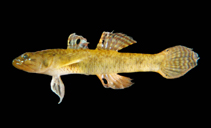| Family: |
Gobiidae (Gobies), subfamily: Gobionellinae |
| Max. size: |
4 cm TL (male/unsexed) |
| Environment: |
demersal; freshwater |
| Distribution: |
Asia: Singapore, Thailand, Malaysia, Brunei and Indonesia (Ref. 43716). Recorded from Myanmar (Ref. 81818). |
| Diagnosis: |
Dorsal spines (total): 6-7; Dorsal soft rays (total): 6-6; Anal spines: 1-1; Anal soft rays: 6-6; Vertebrae: 10-17. Distinguished by the following characteristics: robustly built with second dorsal and anal rays always I, 6; pectoral rays 16-19; longitudinal scales 22-24; TRB 7-9; predorsal scales 6-8, large, reaching close up to behind eyes; preopercular pores absent, posterior portion of oculoscapular canal absent; scales on body mostly ctenoid; third spine of dorsal fin usually longest, but not elongate; head and body pale with margins of scales outlined in brown, row of brown midlateral blotches, three diagonal dark streaks on head and vertically barred caudal fin (Ref. 80545). |
| Biology: |
Known only from freshwater habitats, including blackwater streams; found syntopically with Pseudogobiopsis ologactis (Ref. 80545). Occurs in lowland floodplain canals. Feeds on insects and other invertebrates (Ref. 12693). Adult females are about 1.0 cm smaller than males. Reported gravid female at 2.0 cm SL (from Kapuas River) with numerous eggs, 0.20 mm diameter, while gravid female at 2.29-2.43 cm SL (from Singapore) had noticeably smaller eggs, 0.15 mm diameter (Ref. 2091). |
| IUCN Red List Status: |
Least Concern (LC); Date assessed: 23 December 2018 Ref. (130435)
|
| Threat to humans: |
harmless |
Source and more info: www.fishbase.org. For personal, classroom, and other internal use only. Not for publication.

